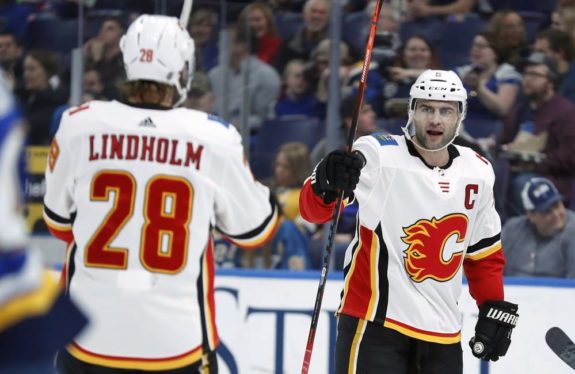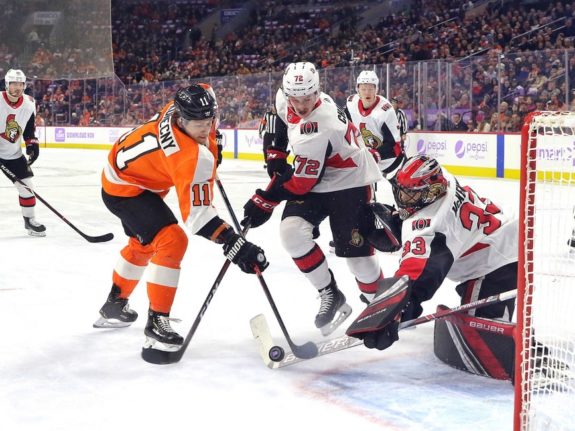Calgary Flames defenceman Mark Giordano remembers a time not that long ago when playing the position was more about giving ground than taking it.
He might try holding the blue line on a clearing attempt in the offensive zone, but otherwise the idea was usually to retreat and regroup.
Not anymore. Not in today’s NHL.
“This is the most active I’ve ever seen defencemen in the league in my career,” Calgary’s 35-year-old captain said. “Every team is so well-coached that there’s really nothing off the rush unless you put your (defencemen) in the rush.”
Giordano, John Carlson of the Washington Capitals, Morgan Rielly of the Toronto Maple Leafs and Thomas Chabot of the Ottawa Senators are each averaging more than a point per game this season.
Heading into Wednesday’s action, Carlson led all blue-liners on a per-outing basis with 35 points in 31 games (1.13 average) followed by Giordano’s 35 points in 33 games (1.06 average), Rielly’s 36 points in 34 games (1.06 average) and Chabot’s 36 points in 35 games (1.03 average).
Brent Burns (0.97) of the San Jose Sharks, Keith Yandle (0.94) of the Florida Panthers and Dustin Byfuglien (0.93) of the Winnipeg Jets are just off the pace.
Only three defenceman have averaged a point per game or better in a full season since the mid-1990s — Nicklas Lidstrom in 2005-06, Mike Green in both 2008-09 and 2009-10, and Erik Karlsson in 2015-16. Green, it should be noted, only played 68 and 75 games, respectively, in his banner campaigns.

No season has seen more than one defenceman finish at a point-per-game pace since 1995-96, when Ray Bourque, Brian Leetch and Sergei Zubov accomplished the feat. Zubov only played 68 games that season, while Paul Coffey just missed out with 74 points in 76 games.
More than any other time in a generation, the current crop of defencemen are jumping up to help a team’s forwards in transition, making aggressive plays in the neutral zone and keeping pucks alive with a pinch.
“You need a fourth man,” explained Giordano, whose career-high for points in a season is 56.
Scoring is up across the board in the NHL, with an average 6.19 goals per game so far in 2018-19. If that number holds it would surpass the post-lockout 2005-06 season (6.17) and be the most since 1995-96 (6.29).

While there are some gaudy numbers among the league’s forwards — Colorado Avalanche winger Mikko Rantanan leads with 56 points and Washington sniper Alex Ovechkin already has 29 goals — Rielly said he’s seen a noticeable jump in defenceman doing their part since he joined the league in 2013.
“It’s become a bit more common,” said the 24-year-old. “It’s important for guys like me, and for other guys who feel like they can contribute, to do that.”
There’s little doubt rule changes aimed at creating more room for players and the implementation of smaller goalie equipment are contributing to the bump in offence, but Buffalo Sabres head coach Phil Housley said tactics have also shifted when it comes to activating defenders.
“It’s just the team structure,” said the Hall of Fame blue-liner with five point-a-game seasons to his name. “A lot has to do with defencemen adding to the rush or, in the offensive zone, getting involved in the cycle.
“It’s really more of a five-man attack.”
Flames head coach Bill Peters said defencemen are now coming into to the league wanting to push the pace after doing the same in minor hockey, junior and university.
“The way they’re being developed has changed,” he said. “They’re up in the rush, they’re leading the rush.
“As (NHL) coaches, you probably more have to rein them in than encourage them go get in the rush.”
Peters added that willingness to go forward is a double-edged sword at the other end of the ice, which in turn leads to even more goals.
“It also shows some inefficiencies amongst young guys,” he said. “The league is probably not as good defensively as it has been.
“But the flip side of that is there’s a lot of excitement.”
And while Carlson, Giordano, Rielly and Chabot have had great starts, Leafs head coach Mike Babcock, who got a first-hand look at Lidstrom for seven season behind the Detroit Red Wings’ bench, preferred not to assess the current crop of offensive defencemen before the 40-game mark.

“Those guys are good players and can really skate,” Babcock said. “But I think 82 games has a way of levelling things out.”
Time will tell in a league continuing to trend towards more goals.
SCHNEIDER’S FALL
Placed on injured reserve with an abdominal strain earlier this week, Cory Schneider has had a rough 12 months. The New Jersey Devils goalie, who lost the starting job to Keith Kinkaid last season, hasn’t won since Dec. 27, 2017, and is 0-15-3 in his last 19 regular-season starts with an .859 save percentage and a 4.26 goals-against average.
PUTTING COLORADO’S FIREPOWER INTO PERSPECTIVE
Colorado’s top line of Mikko Rantanen, Nathan MacKinnon and Gabriel Landeskog have combined for 150 points through their team’s 34 games. That’s more than the Los Angeles Kings’ entire forward group (149 points in 35 games).
___
With files from Canadian Press sports reporter Donna Spencer and Associated Press hockey writer Stephen Whyno
___
Follow @JClipperton_CP on Twitter
Joshua Clipperton’s weekly NHL notebook is published every Wednesday
Joshua Clipperton, The Canadian Press